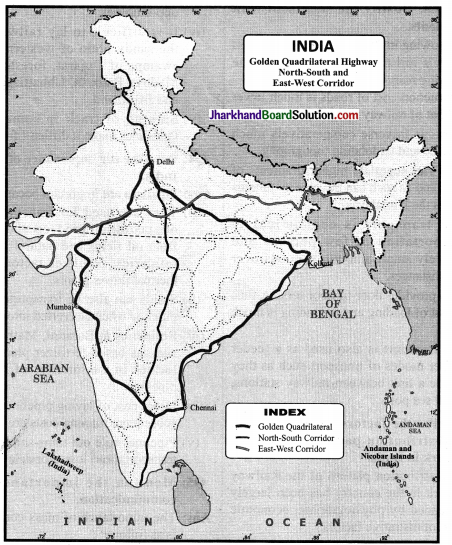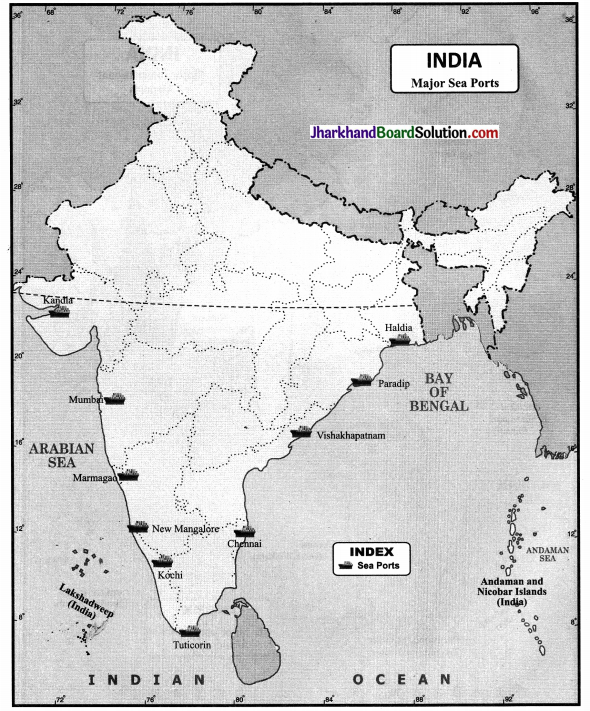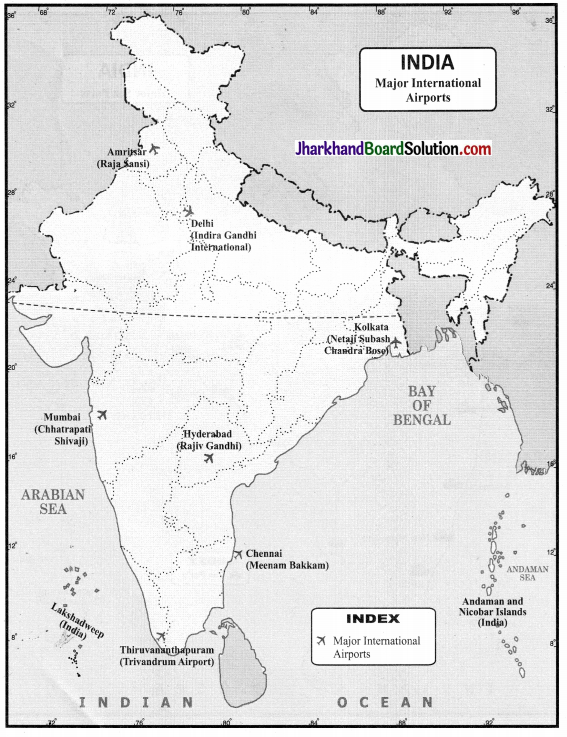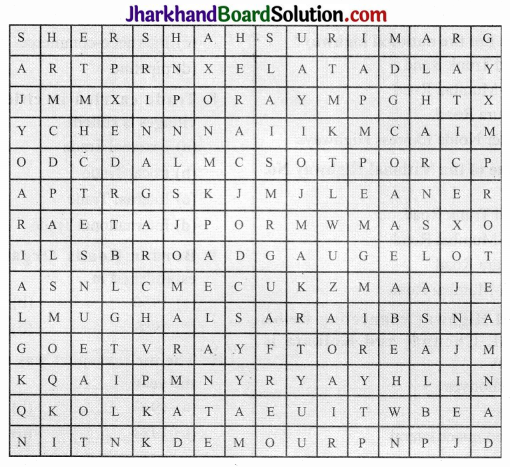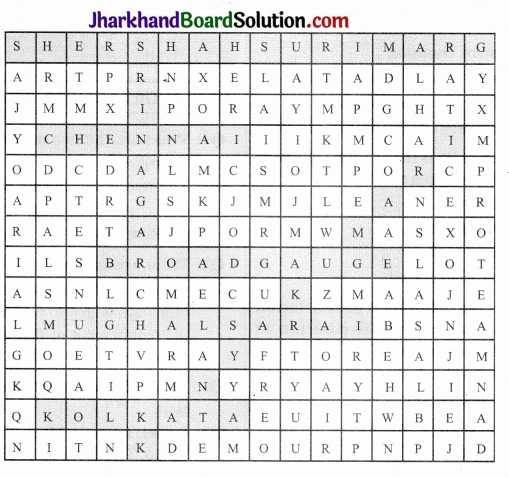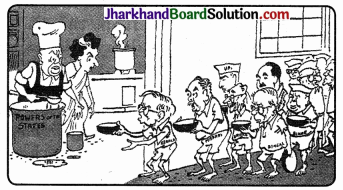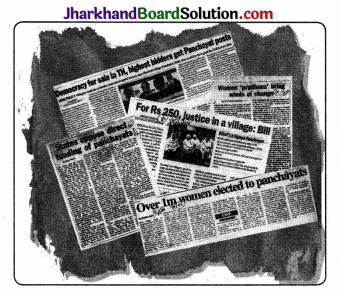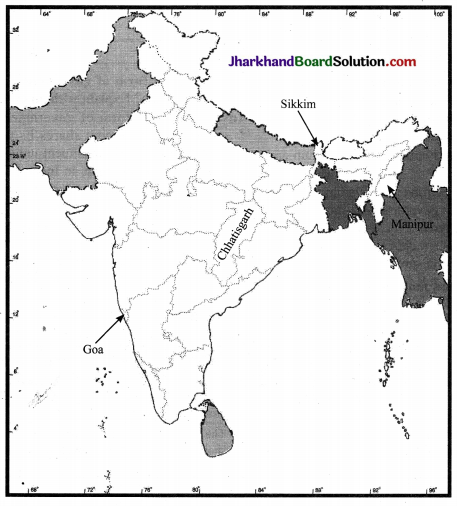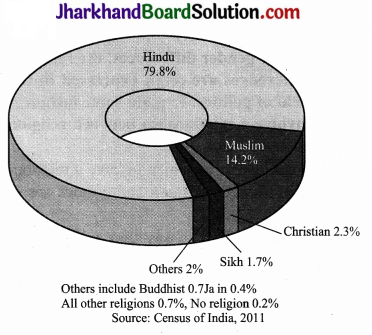JAC Board Class 10th Social Science Solutions Civics Chapter 7 Outcomes of Democracy
JAC Class 10th Civics Outcomes of Democracy InText Questions and Answers
Page 91
Question 1.
Can you think of what and how the government knows about you and your family (for example ration cards and voter identity cards)? What are the sources of information for you about the government?
Answer:
The government comes to know about us and our family through:
- Census: Every ten years, the government conducts census. The surveyors visit homes to know the age sex, family background, professional background, and home town of residents. These details are analysed and published in general in Census reports.
- The government maintains records of birth death and marriage through registrations. We come to know about the policies and programmes of the government through various political parties, Right to Information (RTI) Act, and various governmental department websites.
Page 93
Question 2.
The cartoon on this page and next three pages tell us about the disparities between the rich and poor. Should the gains of economic growth be evenly distributed? How can the poor get a voice for a better share in a nation? What can the poor countries do to receive a greater share in the world’s wealth?
Answer:
Yes, the gains of economic growth should be evenly distributed. Pressure groups or welfare organisations may be formed so that the poor can voice their grievances and opinions to the government. They may write down their suggestions in a letter, do a signature campaign and submit the letter to the Prime Minister for action. They may also form small action groups to utilise their talents and put them to use.
![]()
Page 94
Question 3.
What would be your verdict on democracy if you had to base it purely on economic performance of democratic regimes in terms of growth and equal distribution?
Answer:
As seen in Table 1, the growth rate of all democratic regimes has been 3.95 percent while it has been 4.42 percent for all dictatorial regimes for the last 50 years. The dictatorial nations have performed better in terms of economic growth as compared to democratic regimes. However, when we look at the economic growth of poor countries under dictatorship (4.34 percent) and poor countries under democracy (4.28 percent), the difference is negligible. In Table 2, with regards to distribution of national income, in most countries, the top 20 percent of the population fetch more than 50 percent of national income while bottom 20 percent get less than 10 percent of the share in national income. This reflects unequal distribution of national income.
Page 95
Question 4.
Democracy is a rule of the majority. The poor are in majority. So democracy must be a rule of the poor. How can this not be the case?
Answer:
Yes, the poor are in a majority. But rule by majority does not become rule by majority community in terms of religion or race or linguistic group, etc. Rule by majority means that in case of every decision or in case of every election, different persons and groups may and can form a majority. Therefore, it cannot be rule of poor people always as it will cause a division in the society. Democracy remains democracy only as long as every citizen has a chance of being in majority at some point of time.
Page 96
Question 5.
All you are saying is that democracy ensures that people do not break each other’s head. This is not harmony. Should we be happy about it?
Answer:
No society can fully and permanently resolve conflicts among different groups. But one can certainly learn to respect these differences and also evolve mechanisms to negotiate the differences. Democracy is best suited to produce this outcome. Democracy stands as much superior to any other form of government in promoting dignity and freedom of the individual.
![]()
Page 97
Question 6.
The two images depict two different kinds of effects democratic politics can have on social divisions. Take one example for each image and write a paragraph each on the outcome of democratic politics in both situations.
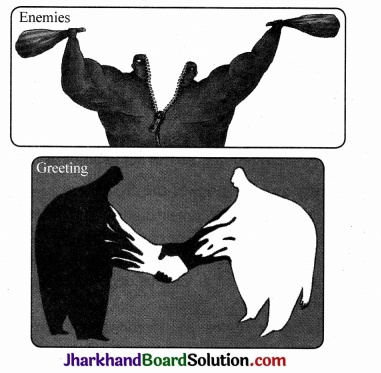
Answer:
The first image reflects how democratic politics can create a division in the society on the basis of caste, race, religion, etc. It can cause differences amongst people in the society and lead to conflicts. This is not healthy for democracy. The second image reflects that in a democracy, differences can be resolved without conflicts when majority works along with the minority. Rule by majority means in case of every election, different persons and groups may and can form a majority. Democracy remains a democracy only as long as every citizen has a chance of being in a majority at some point of time.
Page 98
Question 7.
Rosa Parks Still Inspires The above cartoon and graph illustrate a point made in this section (Dignity and freedom of the citizens). Underline the sentences from this section which connect to the cartoon or graph.
Answer:
Rosa Parks was an American activist in the civil rights movement in the United States. She refused to vacate her seat in the bus in the ‘coloured section’ to a White passenger, after the Whites – only section was filled. This cartoon reflects the’ discrimination faced by people on the basis of colour, race, caste, etc. Every nation had to struggle for equal rights and equal opportunities.
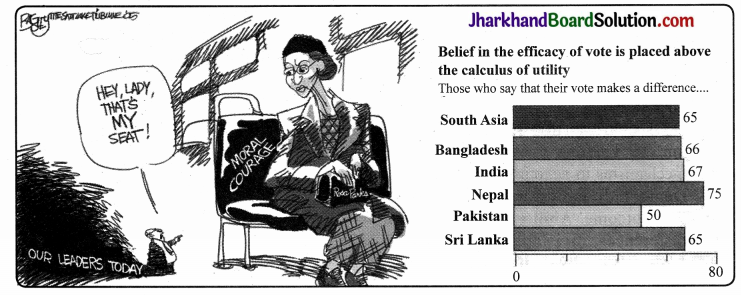
JAC Class 10th Civics Outcomes of Democracy Textbook Questions and Answers
Question 1.
How does democracy produce an accountable, responsive and legitimate government?
Answer:
Democracy produces an accountable, responsive and legitimate government:
(i) Accountable government:
The most basic outcome of democracy is that it produces a government that is accountable to the citizens, and responsive to the needs and expectations of the citizens.
(ii) Responsive government:
Democratic government develops mechanisms for citizens to hold the government accountable and mechanisms for citizens to take part in decision making whenever they think fit. A citizen has the right and the means to examine the process of decision making. This is known as transparency. This factor is often missing from a non – democratic government.
(iii) Legitimate government:
Democratic government is a legitimate government. It may be slow, less efficient, not always responsive or clean. But a democratic government is people’s own government. That is why there is an overwhelming support for the idea of democracy all over the world. People wish to be ruled by representatives elected by them.
![]()
Question 2.
What are the conditions under which democracies accommodate social diversities?
Answer:
Democracies always try to accommodate social diversities.
(i) Democracies usually develop a procedure to conduct their competition. This reduces the possibility of tensions becoming explosive or violent. Democracies accommodate various social divisions. For example, Belgium recognised the existence of regional differences and cultural diversities. It made several adjustments in its constitution to include equal number of Dutch and French speaking ministers in the central government.
(ii) One should learn to respect the differences among various groups and evolve mechanisms to negotiate the differences. Democracy is best suited to produce this outcome. Ability to handle social differences, divisions and conflicts is a plus point of democratic regimes. Democracy must fulfil two conditions in order to achieve this outcome:
- The majority always need to work with the minority so that governments function to represent the general view.
- Rule by majority does not become rule by majority community in terms of religion or raceor linguistic group, etc. Rule by majority means that in case of every decision or in case of every election, different persons and groups may and can form a majority. Democracy remains a democracy only as long as every citizen has a chance of being in majority at some point of time.
Question 3.
Give arguments to support or oppose the following assertions:
(a) Industrialised countries can afford democracy but the poor need dictatorship to become rich.
(b) Democracy can’t reduce inequality of incomes between different citizens.
(c) Government in poor countries should spend less on poverty reduction, health, education and spend more on industries and infrastructure.
(d) In democracy all citizens have one vote, which means that there is absence of any domination and conflict.
Answer:
(a) In opposition to this statement:
It is not true that industrialised countries can afford democracy but the poor need dictatorship to become rich. Democracy is the preferred form of governance these days. It is a better form of government when compared with dictatorship or any other alternatives. India became independent in 1947 and was included in Third World countries. Now it is one of the fastest economies. Under Robert Mugabe’s authoritarian regime from 1987 to 2017, there was widespread human rights violation.
(b) In opposition to this statement:
It is not true that democracies cannot reduce inequalities of income between different citizens. The Minimum Wages Act enacted by the government takes care of the small farmers and small industrialists. Several schemes have been introduced by the government such as Jawahar Rojgar Yojna, Integrated Rural Development Program, Kasturba Gandhi Balika Vidyalaya, Livestock Insurance Scheme, etc.
(c) In opposition to this statement:
In a developing country like India, it is not possible for the government to spend less on poverty reduction, health and education, and spend more on industries and infrastructure. The poor and weaker class need support of the government for basic facilities and it is the responsibility of a democratic government to try to bring about equality in the society through providing services and subsidies for the economically weaker section.
(d) In support of this statement:
Universal Adult Franchise is followed in democracies where each adult citizen gets the right to cast one vote. Though there may be conflicts and differences between various groups and political parties, these are resolved in a constitutional manner.
![]()
Question 4.
Identify the challenges to democracy in the following descriptions. Also suggest policy/institutional mechanism to deepen democracy in the given situations:
(a) Following a High Court directive a temple in Orissa that had separate entry doors for dalits and non – dalits allowed entry for all from the same door.
(b) A large number of farmers are committing suicide in different States of India.
(c) Following allegation of killing of Three civilians in Gandwara in a fake encounter by Jammu and Kashmir police, an enquiry has been ordered.
Answer:
(a) A democracy faces several challenges. The challenges of inequality and untouchability have been identified here. There are many divisions in the society. There are ways to deal with such issues. In this case the High Court took action and allowed the dalits and non – dalits to enter from the same door. To deepen democracy, there should be laws instated in the Constitution of India banning discrimination on the basis of caste, religion or any other factors.
(b) The challenges of poverty are being highlighted here. The government should bring out schemes and programmes for the support of farmers. They should be given seeds, fertilisers, pesticides at subsidised rates. The farmers should be given loans at low interest rates.
(c) This issue reflects the challenges of dignity and freedom of citizens, trust of the people in the government and challenges of corruption. There should be transparency in the working of the various government departments, including the police department. There should be a stringent action against such issues and peace should be restored in the State.
Question 5.
In the context of democracies, which of the following ideas is correct – democracies have successfully eliminated:
(a) conflicts among people.
(b) economic inequalities among people.
(c) differences of opinion about how marginalised sections are to be treated.
(d) the idea of political inequality.
Answer:
(d) the idea of political inequality.
Question 6.
In the context of assessing democracy which among the following is odd one out. Democracies need to ensure:
(a) free and fair elections
(b) dignity of the individual
(c) majority rule
(d) equal treatment before law
Answer:
Democracies need to ensure all the above. It needs to hold free and fair elections, promote the dignity of the individual, ensure majority rule and provide equal treatment before law.
Question 7.
Studies on political and social inequalities in democracy show that
(a) democracy and development go together.
(b) inequalities exist in democracies.
(c) inequalities do not exist under dictatorship.
(d) dictatorship is better than democracy.
Answer:
(b) inequalities exist in democracies.
![]()
Question 8.
Read the passage below:
Nannu is a daily wage earner. He lives in Welcome Mazdoor Colony, a slum habitation in East Delhi. He lost his ration card and applied for a duplicate one in January 2004. He made several rounds to the local Food & Civil Supplies office for the next three months. But the clerks and officials would not even look at him, leave alone do his job or bother to tell him the status of his application. Ultimately, he filed an application under the Right to Information Act asking for the daily progress made on his application, names of the officials, who were supposed to act on his application and what action would be taken against these officials for their inaction. Within a week of filing application under the Right to Information Act, he was visited by an inspector from the Food Department, who informed him that the card had been made and he could collect it from the office.
When Nannu went tocollect his card next day, he was given a very warm treatment by the Food & Supply Officer (FSO), who is the head of a Circle. The FSO offered him tea and requested him to withdraw his application under the Right to Information Act, since his work had already been done. What does Nannu’s example show? What impact did Nannu’s action have on officials? Ask your parents their experiences when they approach government officials to attend their problems.
Answer:
This example shows that the government officials in certain departments are very relaxed and not proactive to the needs and requirements of the people. The government officials have realised that there are laws which the citizens can use for taking action against people or departments for non-performance or non – functioning. The officials need to perform their duty. The Right to Information Act has been of great help to the people.
The citizens are aware of various laws and can pressurise the officials and take action against them. The government health departments are also sometimes very relaxed. The doctors are often not regular in their duties. They usually get occupied in administrative work and do not look after their patients. Sometimes strict action needs to be taken to wake up the officials and get them into action.
